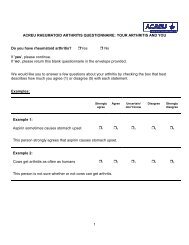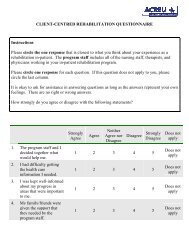Client-Centred Rehabilitation - Arthritis Community Research ...
Client-Centred Rehabilitation - Arthritis Community Research ...
Client-Centred Rehabilitation - Arthritis Community Research ...
Create successful ePaper yourself
Turn your PDF publications into a flip-book with our unique Google optimized e-Paper software.
Articles considered relevant from the search<br />
pattern were reviewed by the <strong>Client</strong>-<strong>Centred</strong><br />
<strong>Rehabilitation</strong> Group in ACREU and<br />
entered into a reference manager database.<br />
The database focused on the following<br />
areas:<br />
General Practice<br />
<strong>Rehabilitation</strong> (OT, PT, SLP, Audiologists)<br />
Healthcare / care<br />
Hospital/Long term care<br />
Clinic<br />
Specialist<br />
Social Work<br />
Nursing<br />
The articles reviewed could be broadly<br />
categorized as professional level and<br />
systems level. The professional level articles<br />
give attention to interactions between the<br />
health professional and the client. The<br />
systems level articles focus on the context in<br />
which care is provided.<br />
2.2 Defining <strong>Client</strong>-<strong>Centred</strong><br />
<strong>Rehabilitation</strong><br />
One of our first challenges was to find a<br />
consistent, overarching definition of clientcentred<br />
rehabilitation. A client-centred<br />
approach is identified in the paper<br />
“Managing the Seams: Making the<br />
<strong>Rehabilitation</strong> System Work for People”<br />
(Provincial <strong>Rehabilitation</strong> Reference Group,<br />
2000) as one that facilitates responsive,<br />
individually appropriate, functionally-based<br />
goal setting involving the active and<br />
informed participation of the client.<br />
Beginning with this definition, we searched<br />
the literature for definitions and conceptual<br />
models that would help us further define the<br />
components of client-centred rehabilitation.<br />
In particular, we were looking for<br />
definitions and models that would apply to<br />
the rehabilitation of adult clients with<br />
chronic physical disability. We took a broad<br />
systems approach that examined clientcentredness<br />
at a variety of levels such as<br />
individual client/practitioner encounters,<br />
programs and organizations.<br />
We quickly found that the terminology used<br />
in the literature is inconsistent and includes<br />
a variety of terms such as client-centred<br />
practice, patient-centred care, and patient<br />
focused care. We identified two main<br />
categories of literature: individual client/<br />
practitioner level literature and system level<br />
literature. Within these literatures, the three<br />
terms above are used with different<br />
meanings.<br />
Much of the work on the individual client /<br />
practitioner relationship tends to be<br />
profession-specific. Different professional<br />
literatures reveal varying definitions and<br />
approaches to client-centred care. These<br />
professional definitions tend to focus on<br />
individual client/practitioner interactions<br />
from each profession’s perspective. Some<br />
professions are much further along in their<br />
thinking in this area than others.<br />
Occupational therapists in particular have<br />
been talking about client-centred practice for<br />
almost 20 years and are much further down<br />
the road than some other groups.<br />
In the Canadian Occupational Therapy<br />
literature client-centred practice refers to<br />
“collaborative approaches aimed at enabling<br />
occupation with clients who may be<br />
individuals, groups, agencies, governments,<br />
corporations or others. Occupational<br />
therapists demonstrate respect for clients,<br />
involve clients in decision making, advocate<br />
with and for clients in meeting clients=<br />
needs, and otherwise recognize clients=<br />
experience and knowledge@ (p.49,<br />
Townsend et al., 1997). This definition<br />
seemed closest to what we were trying to<br />
8








